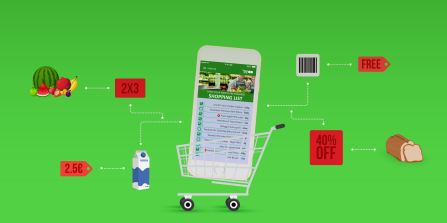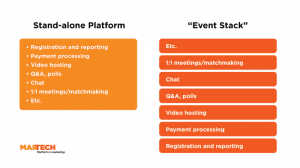
Groceries account for 19% of consumer spending as noted from Morgan Stanley Research and AlphaWise. Looking at the US alone, the grocery industry estimates to a net worth of 675 billion USD! With this lucrative opportunity at hand, there’s no better way to drive this rapidly growing industry than with empowered supermarket apps. Given the fact that 90% of digital time is spent in apps according to ComScore, by leveraging the mobile app opportunity, supermarket apps should offer exceptional mobile experiences to its consumers so that it drives brand awareness, sales and ideally brand advocacy.
However, the grocery industry still has much work to do. Let’s take a look at eCommerce first.
Types of Groceries People Buy Online
Taking a look at the chart below provided by Morgan Stanley. It shows what type of major eCommerce (or online commerce) transactions takes place. One sees that groceries is an auspicious venture considering its anticipated growth starting from 2016 onward. Fresh food takes the lead. Its expected to be the fastest growing margin with 21% to 34% YoY.

The eCommerce grocery trend is likely attributed to the fact that more shoppers are accustomed to buying online. It especially rings true with younger audiences younger who are more mobile-first.
The Challenge with eCommerce Alone
Despite the growth potential in the eCommerce sector of groceries as seen in the chart above, there is still a long way to go if consumers are going to trust ecommerce completely for buying groceries. The Morgan Stanley Research adds, “Given online grocery’s low market share of overall grocery sales (around 2% in the US and 6% in European markets such as the UK, where it has become more mainstream), it offers significant potential for growth.”
Morgan Stanley has pointed out an interesting reason why consumers are still skeptical buying groceries online. Consumers have cited that they prefer to pick the food they want themselves and they prefer the personal experience of browsing inside the store. However, through mobile apps, grocers can integrate the instore experience with eCommerce benefits for a big competitive advantage.
The Omnichannel Approach – Combining Supermarket Apps, eCommerce, Desktop and in-Store
Despite the slow maturity of the grocery eCommerce market, mobile is making headway everywhere. When you include mobile as an integral part of your overall omnichannel strategy, you’re already in the right direction in terms of unlocking your supermarket app for great potential. eCommerce is one aspect of attracting consumers to buy online. Apps are the channel where consumers spend the most time.
A consumer experiences a journey going from in-store, on desktop, to mobile. As Google quotes it, “In many ways, micro-moments [from mobile] have become the footsteps that lead people to your store or desktop site.” The #1 thing a marketer should do is make sure that all these different touch points in the journey are captured. Then, integrate this data from eCommerce sites, CRM, mobile, or other system into a mobile app engagement and analytics platform. Then all that holistic data will become actionable.
See it in Action
Let’s say, it’s a chilly October day and you have a large group of mom shoppers. They downloaded your supermarket app. Your app offers recipes, but you’d like to drive more sales in-store.
You decide to send out an October recipes photo gallery where users choose the recipes. Carla decides to pick out a sweet potato soup. Another mother, Joyce, chooses the asparagus soup.

When Carla taps the recipe, she watches a quick 2-minute video on how to make the soup.

Then the recipe automatically saves in her inbox when she closes the app. One day later, in case Carla doesn’t go to the store, Carla receives a special in-store coupon. “Buy the ingredients in-store and get one-half off bouillon cubes for your sweet potato soup.”

Carla opens it, reads it, then closes the app. The coupon automatically saves in her in-app wallet. Next, you set up a couple of beacons in certain store locations. Place the beacons in certain touchpoints where you find the actual ingredients items based on the recipes. Place a beacon in the produce section where the asparagus and sweet potatoes are located. Or, place a beacon in the aisle where the spices are nearby the vegetable bouillon cubes.
Notify Carla with a friendly reminder when she passes the produce section. Tell her how much she needs, “Hey Carla, gather at least 3 sweet potatoes for 1 serving.” Or notify Joyce on what she needs to know about the asparagus soup. For example, a tip on how to amp up the soup with a ‘secret ingredient’ as she walks by the produce section. Keep in mind, each mobile asset* must be personalized to the utmost degree. Why? Joyce and Carla have different tastes (hence, like two different soups). They have different engagement preferences. They shop in different stores and in different locations. Next, Carla approaches the cashier, near a hidden beacon. A coupon triggers to her smartphone. Plus a reminder, “Do you have 2 packs of bouillon cubes? Get the 2nd one half-off!” “Redeem my coupon now!” as the call-to-action button.
Carla buys her ingredients and redeems her coupon. When she’s home (detected by geo-targeting) send her an offer to share a picture of the soup on social media. If she pins it, tweets, instagrams it, give her 20 loyalty bonus points. Nurture the engagement and thank her for sharing. This is one example of the many personified workflows you will create as you design more intelligent mobile journeys.
Want to learn more? Better debunk the myths first.
Digital & Social Articles on Business 2 Community
(160)
Report Post




